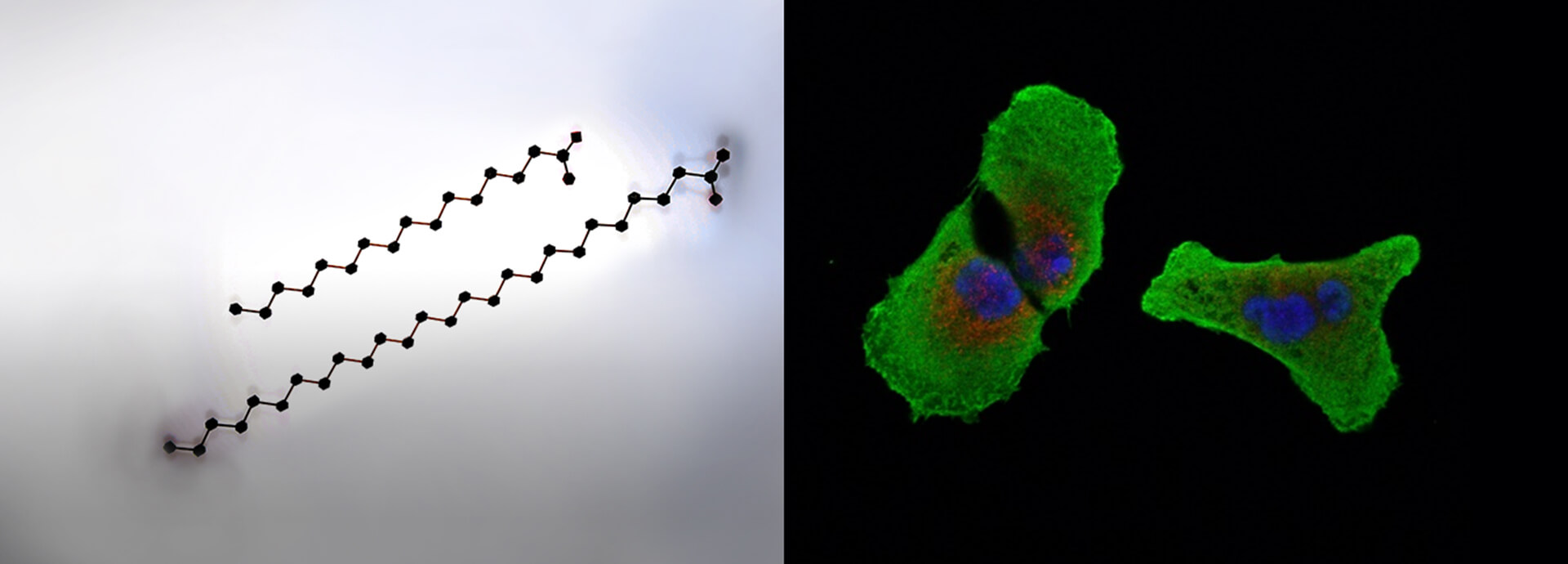Lipid" is one of the three major nutrients,
It has various functions in addition to serving as a source of energy for living organisms.
Recent studies have revealed its relationship with many diseases.
Teikyo University, which has been focusing on the relationship between lipids and diseases for many years Faculty of Pharmaceutical Sciences of the Laboratory of Physicopharmaceutics
Kazuaki Yokoyama Professor and Hirotaro Hama Associate Professor are,
discovered the relationship of very long-chain fatty acids to colorectal cancer and inborn errors of metabolism.
They have also developed their own molecular probes to track the metabolic process of fatty acids,
They are continuing their research to further our understanding of lipids.
A wide variety of structures and functions
Tens of thousands of types of lipids
Of the nutrients that humans ingest from food, the three major nutrients (energy-producing nutrients) are protein, fat, and carbohydrates (sugars), which are the energy sources for the body. Among these, fats are found in large quantities in oils such as salad oil and olive oil, dairy products, and meat, and are necessary sources of energy, but neutral fats and cholesterol can cause lifestyle-related diseases such as obesity. Because of this, they tend to have a bad image.
On the other hand, lipids also play an important role as materials for cell membranes and intracellular information transmitters. Phospholipids, which are one type of lipid, are the main components of cell membranes and have a water-soluble (hydrophilic) head and a water-insoluble (hydrophobic) tail. These phospholipids form a double structure on the cell surface, with their hydrophobic tails facing each other, thereby blocking the inside and outside of the cell. In addition, lipids called prostaglandins act as neurotransmitters and hormones that transmit information within cells and between cells, and are known as physiologically active substances that cause pain and fever.
Three major functions of lipids
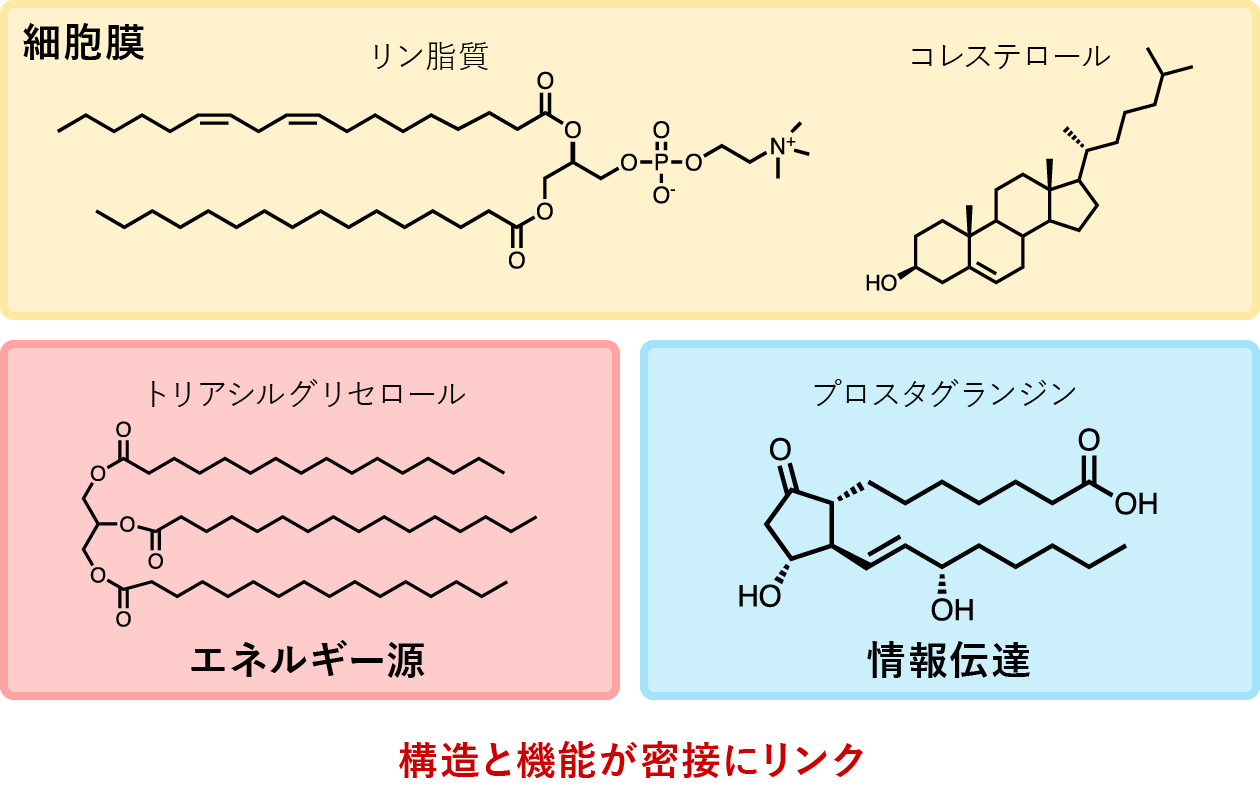

In this way, lipids, which are essential for life activities, are substances made by linking carbon and hydrogen, but depending on how they are linked, they can become a wide variety of lipids with different structures. Based on past biochemical research, it is estimated that there are thousands to tens of thousands of lipids, but some researchers argue that this is only a small portion. Furthermore, differences in structure lead to differences in function and produce various effects within the body.
Associate Professor Kotaro Hama, whose research focuses on the relationship between lipids and diseases, explains as follows.
“Lipid research is endless, as just when you think you have understood the role of a new lipid, another lipid is discovered.However, by using the latest mass spectrometers, it is now possible to comprehensively investigate the structure of lipids. As a result, our understanding of the role of lipids is deepening."
Inborn errors of metabolism and colorectal cancer
Clarifying the relationship between extremely long chain fatty acids
It is said that there are tens of thousands of types of lipids, but Associate Professor and his colleagues are targeting extremely long-chain fatty acids. The properties of fatty acids, which are the basic units that make up lipids, change depending on their length. Compared to short chain fatty acids with 2 to 6 carbon atoms and medium chain fatty acids with 8 or 10 carbon atoms, very long chain fatty acids have 23 or more carbon atoms. It's quite long. When lipids that are naturally difficult to dissolve in water become longer, they become even more difficult to dissolve, and a large amount accumulates in the body, causing various diseases.



One of the diseases that is said to be closely related to extremely long chain fatty acids is inborn errors of metabolism. Congenital metabolic disorders, in which people are born with malfunctions in certain enzymes and excessive amounts of amino acids and carbohydrates accumulate in the body, have a variety of symptoms depending on the substances that accumulate, and many are difficult to treat. Among the inborn errors of metabolism, lipid metabolism disorder (adrenoleukodystrophy), in which lipids accumulate, is a disease with symptoms such as adrenal insufficiency, central nervous system degeneration, and developmental delay, and is designated as an intractable disease in Japan. There is.
There are many unknowns about these diseases, including the mechanism of onset. Associate Professor discovered that in congenital metabolic disorders, extremely long chain fatty acids are regularly bound to some of the phospholipids in cell membranes.
As a biochemist, I would like to clarify even metabolic processes in order to elucidate the mechanism of pathogenesis. With the advent of mass spectrometry, it is now possible to examine individual lipid molecules from the standpoint of molecular weight. Using this technology, Dr. Hama conducted a thorough investigation and found that very long-chain fatty acids are bound to phospholipids in inborn errors of metabolism," says Kazuaki Yokoyama, Professor.
By unraveling the structure of extremely long-chain fatty acids and their metabolic processes within the body, we are attempting to elucidate the mechanisms of the disease itself and its relationship to symptoms.
Similarly, colorectal cancer is another disease that has been linked to lipids. The number of patients with colorectal cancer is still increasing along with the spread of fatty Western diets, but it is still unclear which lipids are "bad". Hama Associate Professor focused on this part of the disease, and through joint research with the Teikyo University Hospital Surgery Lower Gastrointestinal Group and others, found that very long-chain fatty acids in the form of triglycerides (triacylglycerols), not phospholipids, accumulate in the tumor site of colon cancer.
Senior Assistant Professor Shirasaki's research focuses on finding the key to enhancing the efficacy of multiple myeloma, rather than directly treating multiple myeloma. Using an experimental tool called "CRISPR screening" that he acquired while studying in the United States, he will analyze tens of millions of cells to find genes related to drug resistance and treatment sensitivity. For example, identify which gene causes resistance in cells treated with anticancer drugs, and administer another drug (combination drug) that targets that gene so that the anticancer drug is effective for a long time. make it
Make fatty acids “heavy”
Measured with a mass spectrometer
The only way to examine fatty acids using conventional testing methods is to measure the composition of fatty acids broken down by hydrolysis or enzymatic action. However, in order to clarify the involvement of long-chain fatty acids in inborn errors of metabolism and colorectal cancer, it is necessary to clarify how fatty acids undergo chemical changes in the body and the metabolic process. Therefore, Associate Professor first developed a molecular probe that detects oxidized lipids and fatty acids using a mass spectrometer.
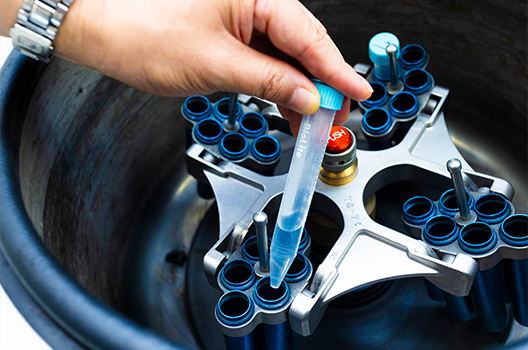
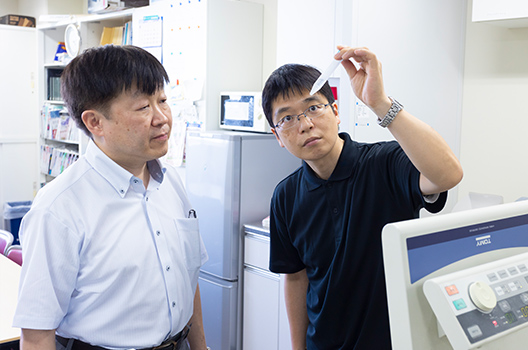
"The molecular probe we developed in collaboration with organic chemistry researchers is an artificial lipid that is metabolized in place of the target lipid, and it is possible to incorporate the artificial lipid into cells and living organisms to track metabolic processes. We can do that,” Associate Professor explains. The artificial lipids created are made by replacing all four light hydrogens that bond to specific carbons in oxidized fatty acids with deuterium (a stable isotope) (deuteration). This fatty acid, which has four hydrogen atoms heavier, is introduced into cells and measured using a mass spectrometer. By detecting only molecules that are heavier than originally, it is possible to observe the metabolic process of the fatty acid of interest.
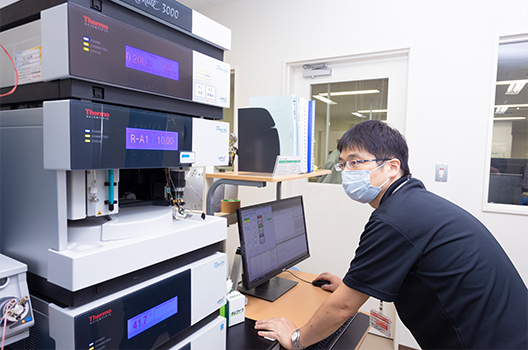

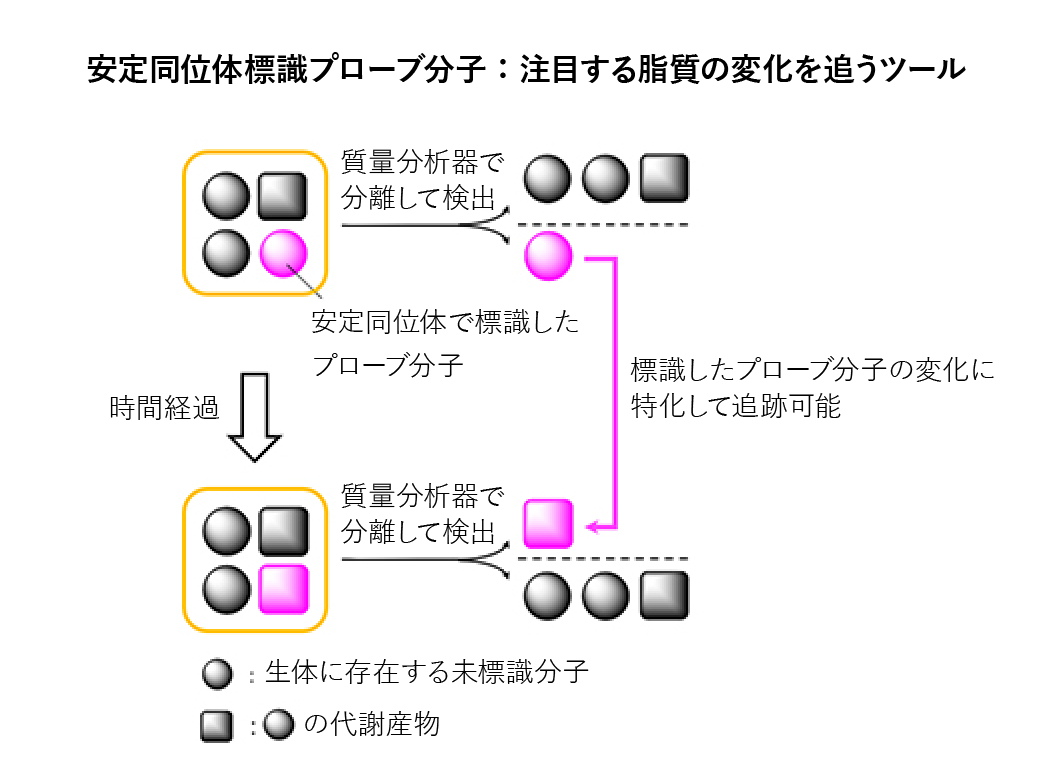
This molecular probe uses catalysts and reagents containing deuterium atoms that are inexpensive and easy to handle, so it can be easily applied to the analysis of a huge variety of lipids. Taking advantage of this mechanism, we can not only track the metabolic process of lipids, but also use it as a biomarker by discovering lipid accumulation that is specific to certain diseases such as colon cancer. It is said that it will be done.
LC-MS measurement example
Example of measuring biological lipids using a mass spectrometer (LC-MS)
Each orange (or brown) dot represents a different type of lipid. Phospholipids and triacylglycerols can be further separated according to their structure and each lipid can be detected.
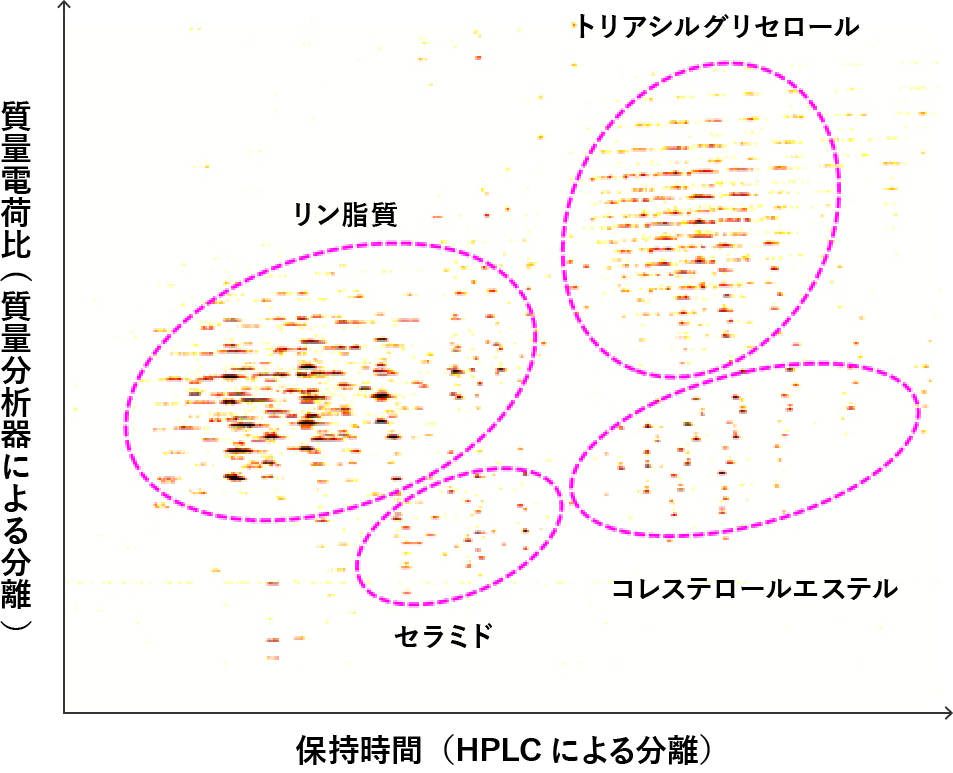
Discover unknown fatty acids
Leading to the elucidation of unknown functions
In recent years, research equipment for investigating fatty acid reactions has advanced, and great progress has been made in elucidating the enzymes that act on lipids. Associate Professor will next focus on the functions of these enzymes, aiming to clarify how each lipid produced by the enzymes is linked to disease.
"For example, we would like to clarify whether very long chain fatty acids are a direct cause (causal relationship) of inborn errors of metabolism, or whether very long chain fatty acids increase as a result of onset of the disease due to another cause (correlation). If we understand this, we can use it as a therapeutic target for drug discovery and other purposes.'' (Associate Professor)
Since Professor Yokoyama and Associate Professor have focused on lipid research, they say that in the future they hope to uncover as many mysteries as possible about lipids.
``Among the four major components of living organisms: nucleic acids, proteins, sugars, and lipids, only lipids are hydrophobic, and lipids made from enzymes, which are proteins, are not directly coded by genes. That's why it's so interesting, and now the relationship between various diseases is becoming clearer.I'm proud that this research is important for future medical care.'' (Professor Yokoyama)
“Lipids are substances whose structure is closely linked to function, and I really like the clear logic that elucidating the mechanism that regulates structure can directly lead to understanding function.I hope to continue this fascinating research on lipids. I also have a dream of eventually discovering new lipids myself.'' (Associate Professor)


Lipids have played an important role in the birth of life, as it is said that the origin of life lies in the membranes that surround cells. Research is progressing with the passion of researchers who are fascinated by lipids to ``unravel the mysteries of lipids'' and the desire to ``contribute to medicine by clarifying the relationship between lipids and disease.''




